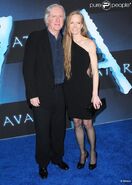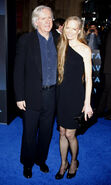| James Francis Cameron | |
| Biographical information | |
| Nationality: | Canadian |
| Birthplace: | Kapuskasing, Ontario, Canada |
| Occupation: | Film director, producer, editor, screenwriter, environmentalist, explorer, Painter |
James Francis Cameron (born August 16th, 1954) is a Canadian film director, producer and screenwriter. He has written and directed films as disparate as Aliens and Titanic. To date, his directorial efforts have grossed approximately US$1.1 billion domestically, unadjusted for inflation. After a string of landmark feature films, Cameron turned his focus to documentary filmmaking and the co-development of the digital 3-D Fusion Camera System. He returns to feature filmmaking with the science fiction film Avatar, which makes use of the Fusion Camera System technology. Avatar was released on December 18th, 2009.
Background[]
Cameron was born in Kapuskasing, Ontario, Canada, the son of Shirley, an artist and nurse, and Phillip Cameron, an electrical engineer. He grew up in Chippawa, Ontario (now part of the city of Niagara Falls) and attended Stamford Collegiate in Niagara Falls, and his family moved to Fullerton, California in 1971. While he studied physics and English at California State University, Fullerton, Cameron used every opportunity to visit the film archive of USC. To the surprise of many people, although Cameron had a large educational background in the natural sciences, he chose a philosophy major from The University of Toronto in 1973. Cameron says of his time there that he was,

The SS Nomadic at Cherbourg with the Titanic
"Completely self taught in special effects. I'd go down to the USC library and pull any theses that graduate students had written about optical printing, or front screen projection, or dye transfers, anything that related to film technology…if they'd let me photocopy it, I would. If not, I'd make notes."
After dropping out, he worked several jobs such as truck driving and wrote when he had time. After seeing the film Star Wars in 1977, Cameron quit his job as a truck driver to enter the film industry. When Cameron read Syd Field's book Screenplay, it occurred to him that integrating science and art were possible and he wrote a ten minute science fiction script with two friends, entitled Xenogenesis. They raised money and rented a camera, lenses, the film stocks, studio and shot it in 35 mm. To understand how to operate the camera, they dismantled it and spent the first half-day of the shoot trying to figure out how to get it running.
Early Career[]

Cameron in 1986
As Cameron continued educating himself in techniques, he started as a miniature model maker at Roger Corman Studios. Making fast, low-budget productions enabled Cameron to pick up the pace efficiently and effectively, soon becoming an art director in the sci-fi movie Battle Beyond the Stars (1980), and he did special effects work design and direction on John Carpenter's Escape from New York (1981). He consulted on the design of Android (1981), and acted as production designer on Galaxy of Terror (1981).
Cameron was hired as the special effects director for the sequel of Piranha, entitled Piranha II: The Spawning in 1981. However, the director left the project and Cameron was hired by Italian producer Assonitis to take over, giving him his first directorial job. He worked with producer Roger Corman. The interior scenes were filmed in Rome, Italy while the underwater diving sequences were shot at Grand Cayman Island.
The movie was to be produced on Jamaica, but when Cameron arrived at the studio, he discovered his crew was comprised primarily of Italians who spoke no English and the project was under financed. Under duress, Cameron says he had a nightmare about an invincible robot hit man sent from the future to kill him, giving him the idea for The Terminator, which would later catapult his filming career.
Filmology[]
Cameron has made these films in his directing career so far:
- Xenogenesis (1978)

- Piranha II (1981)
- The Terminator (1984)
- Rambo: First Blood (1985)
- Aliens (1986)
- The Abyss (1989)
- Terminator 2: Judgment Day (1991)
- True Lies (1994)
- Strange Days (1995)
- Titanic (1997, 2012-3D Version)
- 2D-3D Battle Across Time
- Dark Angel (2000–2002)
- Avatar (2009)
- Avatar: The Way of Water (2022)
- Avatar 3 (TBA)

- Battle Angel (TBA)
- The Dive (TBA)
- Heavy Metal (TBA)
- The Last Train from Hiroshima (TBA)
Mini-filmology statement.[]
The movies that he has done there are only a few of them that has broken box-ffice records across the world. For example, Titanic, Avatar, and also The Terminator Series. Cameron's first film was only made with only $20,000 (US). It is stated that Titanic beat all the records back in 1997 when it came out for the very first time and when it was re-released in 3D eariler this year on the 6th of April 2012. Nine days before the 100th anniversary of the sinking of the ship. James Cameron has got more movies to do and more franchises to expand. For example, Avater has got another two or three movies still to be written and to be filmed. But it is unknown if James will ever do another Terminator Movie.
Awards[]
Cameron received the Bradbury Award from the Science Fiction and Fantasy Writers of America in 1991—but, being primarily thought of as a genre filmmaker, he did not receive any major mainstream filmmaking awards prior to Titanic. With Titanic, Cameron received the Academy Awards for Best Editing (shared with Conrad Buff and Richard A. Harris), Best Picture (shared with Jon Landau), and Best Director. He also won a Golden Globe for best director for the film.
In recognition of his contributions to underwater filming and remote vehicle technology, the University of Southampton awarded Cameron the honorary degree of Doctor of the University. Cameron received his degree in person at the graduation ceremony in July, 2004.
On June 3, 2008, it was announced that he would be inducted into Canada's Walk of Fame.
Biographical Novel[]
The Futurist: The Life and Films of James Cameron is a biographical novel written by Rebecca Keegan that covers his filmmaking career up to and including the film Avatar.
Personal Life[]
Cameron has been married five times: Sharon Williams (1978–1984), Gale Anne Hurd (1985–1989), Kathryn Bigelow (1989–1991), Linda Hamilton (1997–1999, one daughter), Suzy Amis (2000-, one son, two daughters). Cameron is very distantly related to actress Joanna Cameron who starred as Isis on television in the 1970s.
He has been described by one collaborator, author Orson Scott Card, as selfish and cruel. When asked about working with Cameron on the novelization of The Abyss, Card said the experience was.
After working with Cameron on the set of Titanic, Kate Winslet decided she would not work with Cameron again unless she earned "a lot of money." She admitted Cameron was a nice man, but had too much of a temper.
Cameron is a member of the NASA Advisory Council and is working on the project to get cameras on the pending manned Mars mission.






